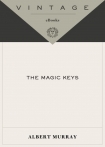The Magic Keys by Albert Murray (romantic story to read txt) 📕

Read free book «The Magic Keys by Albert Murray (romantic story to read txt) 📕» - read online or download for free at americanlibrarybooks.com
- Author: Albert Murray
Read book online «The Magic Keys by Albert Murray (romantic story to read txt) 📕». Author - Albert Murray
I said, Man, ain’t no telling what some Beasley riffs could add up to. I said, Man, how about a series or sequence of From Down-Home to Uptown Sketches, the Natural History of a Hipster, or, say, The Shady Side of the Stem (as in mainstem), or Slapping Seventh Avenue with the Sole of My Shoe, or The Rounder, or The Sidewalk Pounder ? Man, I could go on and on and so could you. Me, I’m just running on and on about something I just thought of.
And he said, Hey, but you’re on to something, man. And then he said, Did old Taft tell you that I took classes with George Grosz at the Art Students’ League? And I said, Ecce homo. And he said, The same. And then said, I was very much into political and social cartoons at that time. But when I went to study with him, he turned out to be the one who really put me on to the fundamentals of serious craftsmanship, and he inspired me to study the world history of art and learn from the great masterpieces.
So like I said, he said, You’re on to something, my man. Then he threw a playful left jab and clinched me and on the break he said, So didn’t you tell me that old Joe States and the Bossman’s wrecking crew called you Schoolboy? Well, that means that they really appreciated what you are really about, and just to show you that I do, too, I’m herewith designating you Chief Literary Consultant. But no kidding, my man, as soon as we got together in Paris, I realized that there were a million things I’d like to talk to you about.
In Paris he had told me that his studio was on 125th Street in Harlem, in the same building as the Apollo Theatre. But when he had answered the phone number that Taft Edison had given me, he said he had moved all the way down to Canal Street near Sixth Avenue, on the way to Chinatown. He had invited me to come down as soon as I could spare the time. But my first and only visit so far had been a very brief pop-in call one afternoon.
Not long after that was the first of the three times that he had stopped by the library to treat me to a snack on the way to the Museum of Modern Art, the Metropolitan Museum, and the galleries on Fifty-seventh Street and along Madison Avenue. This was before the Guggenheim was built, and the Whitney at that time was still down on Eighth Street between MacDougal and Fifth Avenue in Greenwich Village, near where most of the small galleries and studios were located in those days.
On my first trip down to the studio on Canal Street there had been only enough time for me to see the framed paintings, drawings, and sketches of his that were hanging on the walls, along with the framed works of other New York painters who were mostly close personal friends of his. And there were also a few of his framed and unframed and perhaps not quite finished canvases on the floor leaning against the wall, against a chair here and there and the worktable near the easel.
But when I went back the second time, he had brought out a number of framed and unframed but finished pieces from his storage area, and there were also several sketchbooks and folders of drawings and watercolors on the worktable. And when he said what he said about giving me some idea and concrete evidence of what he had been up to and what he was about, I said, It does, man, it does.
And I was impressed but not really surprised because by that time, his responses to what I had gone with him to see in the galleries and museums had given me what turned out to be a very reliable impression of his general aesthetic and intellectual orientation and also what his special individual emphasis was and how it fit into the comprehensive context of the role of art in human consciousness. In fact, at the time of that second visit I had already begun to think of him as someone who just might become my very special visual arts cut-buddy, as Taft Edison was becoming my literary cut-buddy, as my now faraway best of all possible roommates had become during my freshman and sophomore years in college.
Which is why when he said what he said about wanting me to give him my literary response to what he had done, was doing, and would be doing, I said, If you say so, man. Because by that time I also realized that he was as enthusiastic about popping into bookstores and browsing through the literary section with me as I always was about going to exhibitions with him whenever I could spare the time away from my academic assignments.
Man, he said, when I looked at my watch and stood up because it was time to go, I can’t tell you how much I’m looking forward to what we are going to be doing about





Comments (0)